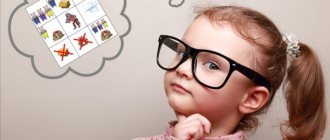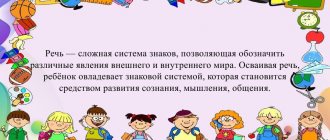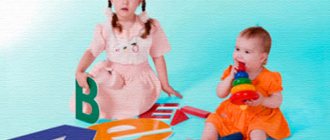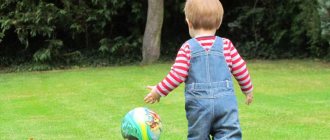Speech development in preschoolers
Normally, by the age of 5-6 years of life, a child’s speech is similar to an adult’s. The main task of developing the ability to correctly express one’s thoughts in a conversation is to prepare a preschooler for learning to read and write. If your baby has difficulty differentiating sounds, he will inevitably have problems writing letters.
A limited vocabulary and inability to consistently express thoughts will not allow the student to retell what he has read or explain the solution to an example.
And you should start preparing for school early and gradually. The tutor will be able to quickly prepare the child. However, the effectiveness of such intensive classes will lose its relevance after 1-2 quarters if the preschooler has speech disorders. Therefore, it is worth starting to prepare for admission to 1st grade 1.5-2 years in advance.
Vocabulary
At 5 years old, a child should actively use about 3-3.5 thousand words. He knows how to generalize concepts (plants, animals, dishes, clothes). In the speech of a preschooler, there are not only the names of everyday objects, but also abstract concepts - love, resentment, planet, universe, etc.
Children 5-6 years old love vocabulary games with rearranging words or making mistakes in the text. Eg:
- The bathhouse ran past the man, and the gate growled at our cat.
- I chopped the ax with my notebook, and the fence jumped over the cat Egorka.
Grammar
Short answers become longer and more detailed. Children already know how to correctly decline complex forms of nouns. However, they may make mistakes by saying kittens instead of kittens or calves instead of calves. The following speech games help develop grammar:
- “Say it the other way around” is a game to find antonyms.
- "Broken phone."
- "Guess what I'm talking about."
- “Finish the sentence.”
The model of literacy is the adults who surround the baby. If family members have problems with the correct placement of stress, speech disorders, or abuse of slang and obscene words, the child will copy them.
Articulation
The vocal apparatus of a preschooler corresponds to that of an adult. If there are no anatomical disorders - a shortened frenulum, malocclusion - children pronounce most phonemes correctly. Most often, children 5-6 years old have difficulty pronouncing the sound “r”. They either replace it with a simpler “l” or “y” - balsuk, not badger, yak, - not cancer, or skip it altogether - baaban instead of drum, vaenik instead of dumpling.
If a child has not learned to pronounce the sound “r” by the age of 5, he will no longer be able to cope with it on his own. You should not expect the child to outgrow the problem. A consultation with a speech pathologist and attendance at speech therapy classes are required.
Another important aspect is long pauses in conversation, or stuttering. This is a complex speech disorder that may take years to resolve. The reason may be:
- increased nervous excitability;
- strict parents;
- too much load on the speech apparatus at an early age;
- imitating a relative or friend who stutters.
Logic and consistency
Coherent speech in a preschooler is the result of many years of efforts by parents involved in its development. Such children speak expressively, use epithets and comparisons, and create their own stories. While the baby, whose speech skills have not been developed by anyone, speaks monotonously and inarticulately.
At 5-6 years old, a child composes a coherent story based on a picture, retells the text he heard, expressing his opinion on what he heard or saw.
Children who spend 90% of their free time on a computer or smartphone have difficulties with the coherence and logic of the narrative. It is difficult for him to answer the question in detail. However, he is ready to talk about his favorite characters in the game for hours. If you do not limit the time you use gadgets, this will negatively affect speech development.
Features of speech development in children of the sixth year of life
The speech of children, the development of which was given much attention by their parents and teachers, at this age stage is practically no different from the speech of adults. The successful mastery of literacy and writing in the first grade largely depends on the level at which it is located. If an older preschooler swaps sounds and syllables in oral speech, he will do this in the same way when writing and reading.
A meager vocabulary and undeveloped coherent speech will, after some time, prevent a child at school from retelling a text from a textbook or explaining how he got the answer to a problem. Moms and dads act recklessly, trying to make up for lost opportunities 3-4 months before entering first grade.
Intensive classes with a tutor may give a short-term advantage to a future first-grader, but this leap forward will lose its significance by the middle of the first school year if the child’s speech is undeveloped. Meanwhile, two years before school, a lot can still be done if you pay close attention to the speech development of children.
Lexicon
The active vocabulary of a five-year-old child has about 3 thousand words. Children already understand exactly what is meant by generalizing words - birds, wild and domestic animals, insects, trees. They master a huge range of concepts, and their knowledge extends not only to everyday objects within sight, but also to rather abstract things. They have accumulated impressive knowledge experience and can talk, for example, about astronautics and human relationships.
The quality of spoken words is also increasing, and annoying errors such as rearranged, added syllables and replaced, added and rearranged sounds appear less and less often in speech. They can now slip only when pronouncing polysyllabic unfamiliar words, for example, hairdresser, traffic controller, electricity, excavator, armored personnel carrier. Word games continue, as do rhyming and poetry writing.
Humorous literary works with permutations of words, as well as all kinds of verbal inversions and riddles, are very popular among children of this age:
Vanya was riding on a horse, leading a dog on a belt, and at that time the old woman was washing a ficus tree on the window.
Vanya was riding on a belt, leading a dog on a horse, and at that time the old woman was washing a ficus tree on the window.
A village was driving past a man. Suddenly the gate A barks from under the dog.
He grabbed the club and cut the ax. And the fence ran over our cat.
Grammar of the native language
If a five-year-old child asks about a familiar topic, he will easily answer it with a complete and detailed sentence. In normal speech, children use simple phrases, which become longer and more common by the age of six. Most of the words in the sentences are used and modified correctly, although there are also incorrect forms, for example, bear cubs and baby elephants instead of cubs and elephants, pencils instead of pencils, glasses instead of glasses.
Children play various word games with great pleasure:
- broken phone;
- what to call it differently (for selection of synonyms);
- say the opposite (search for antonyms);
- what is soft (sweet, tall, wooden);
- recognize the item by description;
- finish the sentence.
A child’s speech will not be grammatically correct if the adults in his immediate environment do not become an example of exemplary pronunciation for him. If they pronounce words incorrectly, place emphasis incorrectly, or abuse profanity, then the child will do the same.
Sound pronunciation
The speech apparatus of a child of the sixth year of life is fully formed and, if there are no deviations in its structure (short frenulum of the tongue, high palate, malocclusion), most sounds are pronounced by children correctly. The most common pronunciation deficiencies at this age are:
- distortion, replacement or absence of sound [l] (mayako - milk, yuka - tree, igoyka - needle, kovodets - well);
- replacement of the sound [r] with the sounds [l] or [th], its complete absence or distortion (yodka - boat, lyba - fish, baan - ram);
Children of this age can already independently notice such shortcomings in themselves and those around them. There is an opinion among preschool speech therapists that sounds that do not appear in the speech of children under five to five and a half years old are unlikely to appear on their own. If your pronunciation is defective or any sound is missing, you need to contact a specialist for examination and corrective classes.
Particular attention should be paid to the appearance of stuttering or speech hesitations. This is a very difficult speech defect, the correction of which can take several years. Stuttering occurs in children when thoughts do not keep up with speech, in children with a weak type of nervous system, with an overly strict family upbringing, and also as a result of a child’s elementary imitation of the speech of a stuttering adult.
Connected speech
It is impossible to give an accurate description of the level of development of coherent speech, which is common for the speech of 5-year-old children. Its range is very wide - from extensive, rich in epithets and the ability to use means of expressiveness (intonation, comparisons), in a child who can compose his own fairy tales, to inexpressive and monotonous in a preschooler, whose speech development no one has studied.
At this age, children can make up a story based on a picture, retell a work of art they have read, share their impressions of a trip, a trip to the theater, a museum, a cartoon they watched, or playing games with friends. They already consciously select the most vivid, precise, and meaningful words in order to more fully express their thoughts.
Unfortunately, some parents do not control the time their children spend on computer games. Even if we do not take into account their negative impact on the psyche, passion for gadgets negatively affects speech development. It’s sad to watch how a preschooler, having difficulty choosing answers to questions about the content of the work he read, a minute later, rushing and choking, enthusiastically talks about his successes in a computer game.
The active development of visual perception of computer reality in such cases occurs to the detriment of auditory speech perception and the ability to coherently express one’s thoughts. If the necessary measures are not taken in time, this can become a serious problem in child development in the future.
Generally accepted standards
Normally, a preschooler:
- Knows and follows the rules of grammar. He may put the emphasis incorrectly on an unfamiliar word or make a mistake when changing it. However, if a parent or teacher corrects him, the children remember and do not make any more mistakes.
- Gives a detailed answer to the question.
- Pronounces sounds articulately and clearly.
- He can compose a logical story based on a picture or a series of photographs, come up with his own beginning or ending to a fairy tale, retell a text he heard, share emotions from watching a cartoon or spending time together, playing a game.
- Describes an object and guesses it from the description.
- Can change intonation, voice volume, speed of speech.
- Participates in theatrical performances (at home or in kindergarten), artistically recites poetry, and makes intonation pauses.
- Selects words that are close or opposite in meaning: joyful and cheerful, laughing and crying.
- Actively uses prefixed verbs: the white door is open and the green door is closed.
- Able to generalize concepts: fork, plate, pan - utensils; cat, mouse, dog, rabbit - pets; eagle, thrush, tit - birds.
- Pronounces most phonemes correctly. The exception is the sound “r”.
Games for the development of speech for children 5-6 years old. Card file on speech therapy (senior group) on the topic
Games to develop coherent speech
“Who talks like that?”
Goal: expanding vocabulary, developing reaction speed. Procedure: the teacher throws the ball to the children one by one, naming the animals. Children, returning the ball, must answer how this or that animal gives a voice: A cow moos A tiger growls A snake hisses A mosquito squeaks A dog barks A wolf howls A duck quacks A pig grunts Option 2. The speech therapist throws the ball and asks: “Who is growling?”, “Who is it?” moos?", "Who barks?", "Who cuckoos?" etc.
"Who lives where?"
Goal: to consolidate children’s knowledge about the homes of animals and insects. Consolidating the use of the grammatical form of the prepositional case with the preposition “v” in children’s speech. Progress: Throwing the ball to each child in turn, the teacher asks a question, and the child, returning the ball, answers. Option 1. teacher: - Children: Who lives in a hollow? - Squirrel. Who lives in a birdhouse? - Starlings. Who lives in the nest? - Birds. Who lives in the booth? - The dog. Who lives in the hive? - Bees. Who lives in the hole? - Fox. Who lives in the lair? -Wolf. Who lives in the den? - A bear. Option 2. teacher: - Children: Where does the bear live? - In a den. Where does the wolf live? - In the lair. Option 3. Work on the correct sentence construction. Children are asked to give a complete answer: “The bear lives in a den.”
"Give me a word"
Goal: development of thinking, speed of reaction. Procedure: the teacher, throwing the ball to each child in turn, asks: - The crow croaks, and the magpie? The child, returning the ball, must answer: “The magpie is chirping.” Examples of questions: – An owl flies, but what about a rabbit? - The cow eats hay, and the fox? - The mole digs holes, and the magpie? - The rooster crows, and the chicken? - The frog croaks, and the horse? - The cow has a calf, and the sheep? – The bear cub has a mother bear, and the baby squirrel?
“What happens in nature?”
Goal: to consolidate the use of verbs in speech, the agreement of words in a sentence. Procedure: the teacher, throwing the ball to the child, asks a question, and the child, returning the ball, must answer the question asked. It is advisable to play the game by topic. Example: Theme “Spring” teacher: - Children: The sun - what is it doing? - It shines, it warms. Streams - what are they doing? - Running, babbling. Snow - what does it do? - It gets dark, melts. Birds - what are they doing? - They fly in, build nests, sing songs. Drops - what does it do? - Rings, drips. The bear - what is it doing? - Wakes up, crawls out of the den.
“Who moves how?”
Goal: enriching children's verbal vocabulary, developing thinking, attention, imagination, dexterity. Procedure: the teacher, throwing a ball to each child, names an animal, and the child, returning the ball, pronounces a verb that can be attributed to the named animal. teacher: -Children: Dog - stands, sits, lies, walks, sleeps, barks, serves (cat, mouse...)
"Hot Cold"
Goal: to consolidate in the child’s mind and vocabulary the opposite characteristics of objects or antonym words. Procedure: the teacher, throwing the ball to the child, pronounces one adjective, and the child, returning the ball, names another - with the opposite meaning. teacher: -Children: Hot-cold Good-bad Smart-stupid Cheerful-sad Sharp-dull Smooth-rough
“What happens in nature?”
Goal: to consolidate the use of verbs in speech, the agreement of words in a sentence. Procedure: the teacher, throwing the ball to the child, asks a question, and the child, returning the ball, must answer the question asked. It is advisable to play the game by topic. Example: Theme “Spring” teacher: - Children: The sun - what is it doing? - It shines, it warms. Streams - what are they doing? - Running, babbling. Snow - what does it do? - It gets dark, melts. Birds - what are they doing? - They fly in, build nests, sing songs. Drops - what does it do? - Rings, drips. The bear - what is it doing? - Wakes up, crawls out of the den.
“Who can perform these actions?”
Goal: activation of children's verbal dictionary, development of imagination, memory, dexterity. Procedure: the teacher, throwing the ball to the child, names the verb, and the child, returning the ball, names the noun that matches the named verb. teacher: - Children: Walking - a man, an animal, a train, a steamboat, rain... Running - a stream, time, an animal, a man, a road... A bird, a butterfly, a dragonfly, a fly, a beetle, an airplane flies... A fish, a whale, a dolphin floats. , boat, ship, man...
“What is it made of?”
Goal: to consolidate the use of relative adjectives and methods of their formation in children’s speech. Procedure: the teacher, throwing the ball to the child, says: “Boots made of leather,” and the child, returning the ball, replies: “Leather.” teacher: -Children: Fur mittens, copper basin, copper vase, crystal, wool mittens, wool
"Put it into pieces"
Goal: orientation in space. Progress: the character Fedora asks the guys to help her: put pots and pans on the bottom shelf, plates, spoons, knives, forks - on a higher shelf, and saucers and jugs on the top shelf.
“Who was who?”
Goal: development of thinking, expansion of vocabulary, consolidation of case endings. Procedure: the teacher, throwing a ball to one of the children, names an object or animal, and the child, returning the ball to the speech therapist, answers the question of who (what) the previously named object was: Chicken – egg Bread – flour Horse – foal Wardrobe – board Cow – calf Bicycle – iron Dud – acorn Shirt – cloth Fish – egg Boots – leather Apple tree – seed House – brick Frog – tadpole Strong – weak Butterfly – caterpillar Adult – child
“Which vegetable?”
Goal: development of tactile, visual and olfactory analyzers. Procedure: teacher cuts vegetables, children smell and taste them. The teacher gives an example: “The tomato is sweet, but the garlic is spicy.”
“What does it sound like?”
Goal: development of auditory attention and observation. Procedure: the teacher plays various musical instruments behind a screen (tambourine, bell, wooden spoons). Children must guess what it sounds like.
“What happens in the fall?”
Goal: to teach the seasons, their sequence and main features. Procedure: on the table are mixed pictures depicting various seasonal phenomena (it is snowing, a flowering meadow, an autumn forest, people in raincoats and with umbrellas, etc.). The child chooses pictures that depict only autumn phenomena and names them.
“What’s missing?”
Goal: development of attention and observation. Procedure: the teacher lays out 4 vegetables on the table: “Children, look carefully at what is on the table. These are onions, cucumbers, tomatoes, peppers. Look carefully and remember. Now close your eyes.” Children close their eyes, and the teacher removes one vegetable. “What’s missing?” Children remember and name the vegetable.
“Catch and throw – name the colors”
Goal: selection of nouns for the adjective denoting color. Reinforcing the names of primary colors, developing children's imagination. Procedure: the teacher, throwing the ball to the child, names an adjective denoting color, and the child, returning the ball, names a noun that matches this adjective. teacher: - Children: Red - poppy, fire, flag Orange - orange, carrot, dawn Yellow - chicken, sun, turnip Green - cucumber, grass, forest Blue - sky, ice, forget-me-nots Blue - bell, sea, sky Violet - plum , lilac, dusk
"Whose head?"
Goal: expanding children's vocabulary through the use of possessive adjectives. Procedure: the teacher, throwing the ball to the child, says: “A crow has the head...”, and the child, throwing the ball back, finishes: “... a crow.” For example: A lynx has a lynx's head A fish has a fish's head A cat has a cat's head A magpie has a magpie's head A horse has a horse's head An eagle has an eagle's head A camel has a camel's head
"The fourth wheel"
Goal: to strengthen children’s ability to identify a common feature in words, to develop the ability to generalize. Procedure: the teacher, throwing a ball to the child, names four words and asks them to determine which word is the odd one out. For example: blue, red, green, ripe. Zucchini, cucumber, pumpkin, lemon. Cloudy, stormy, gloomy, clear.
"One is many"
Goal: to consolidate various types of endings of nouns in children's speech. Procedure: the teacher throws the ball to the children, calling singular nouns. Children throw the ball back, naming plural nouns.
Example: Table - tables chair - chairs Mountain - mountains leaf - leaves House - houses sock - socks Eye - eyes piece - pieces Day - days jump - jumping Sleep - dreams gosling - goslings Forehead - foreheads tiger cub - cubs
"Pick up the signs"
Goal: activation of the verb dictionary. Procedure: teacher asks the question “What can squirrels do?” Children answer the question and find a picture for the question asked. Sample answers: Squirrels can jump from branch to branch. Squirrels know how to make warm nests.
"Animals and their young"
Goal: to consolidate the names of baby animals in children's speech, to consolidate word formation skills, to develop dexterity, attention, and memory. Progress: by throwing a ball to a child, the teacher names an animal, and the child, returning the ball, names the baby of this animal. The words are arranged into three groups according to the method of their formation. The third group requires memorizing the names of the cubs. Group 1. The tiger has a tiger cub, the lion has a lion cub, the elephant has a cub, the deer has a fawn, the elk has a calf, the fox has a fox calf. Group 2. The bear has a baby bear, the camel has a baby camel, the hare has a baby hare, the rabbit has a baby rabbit, the squirrel has a baby squirrel. Group 3. The cow has a calf, the horse has a foal, the pig has a piglet, the sheep has a lamb, the hen has a chick, the dog has a puppy.
“What is round?”
Goal: expanding children's vocabulary through adjectives, developing imagination, memory, dexterity. Procedure: the teacher, throwing the ball to the children, asks a question, the child who caught the ball must answer it and return the ball. -What is round? (ball, ball, wheel, sun, moon, cherry, apple...) - what is long? (road, river, rope, tape, cord, thread...) - what is tall? (mountain, tree, rock, person, pillar, house, closet...) - what is prickly? (hedgehog, rose, cactus, needles, Christmas tree, wire...)
"Pick up a word"
Goal: development of word formation skills, selection of related words. For example, bee - bee, little bee, beekeeper, beekeeper, bees, etc.
"Generalizing concepts"
Goal: expansion of vocabulary through the use of generalizing words, development of attention and memory, ability to correlate generic and specific concepts. Option 1. Move: the teacher names a generalizing concept and throws the ball to each child in turn. The child, returning the ball, must name the objects related to that generalizing concept. teacher: -Children: Vegetables - potatoes, cabbage, tomato, cucumber, radish. Option 2. The teacher names specific concepts, and the children name generalizing words. teacher: Children: Cucumber, tomato-Vegetables.
"Good bad"
Goal: introducing children to the contradictions of the world around them, developing coherent speech and imagination. Procedure: the teacher sets the topic of discussion. Children, passing the ball around, tell what, in their opinion, is good or bad in weather phenomena. Teacher: Rain. Children: Rain is good: it washes away dust from houses and trees, it is good for the earth and the future harvest, but it is bad - it wets us, it can be cold. Teacher: City. Children: It’s good that I live in the city: you can travel by subway, by bus, there are a lot of good shops, but the bad thing is that you won’t see a live cow or rooster, it’s stuffy, dusty.
"Near and Far"
Goal: development of auditory attention, hearing acuity. Procedure: the teacher behind the screen produces sound with a large or small toy. Children determine the size of the toy (large or small) by the strength of the sound.
"Call me kindly"
Goal: strengthening the ability to form nouns using diminutive suffixes, developing dexterity, speed of reaction. Procedure: the teacher, throwing the ball to the child, calls the first word (for example, ball), and the child, returning the ball, calls the second word (ball). Words can be grouped by similar endings. Table-table, key-key. Beanie hat, squirrel squirrel. Book-book, spoon-spoon. Head-head, picture-picture. Soap-soap, mirror-mirror. Doll-doll, beet-beet. Braid-braid, water-water. Beetle-beetle, oak-oak. Cherry-cherry, tower-tower. Dress-dress, chair-chair.
"Fun account"
Goal: to reinforce the agreement of nouns with numerals in children’s speech. Procedure: the teacher throws the ball to the child and pronounces the combination of the noun with the numeral “one”, and the child, returning the ball, responds by calling the same noun, but in combination with the numeral “five”, “ six", "seven", "eight". Example: One table - five tables One elephant - five elephants One crane - five cranes One swan - five swans One nut - five nuts One cone - five cones One gosling - five goslings One chicken - five chickens One hare - five hares One hat - five caps One can – five cans.
Signs of speech underdevelopment
The main sign of speech disorders is a violation of diction and articulation. A child with speech delay pronounces words unclearly, it is difficult to understand him, and as a result, it is extremely difficult to track his speech literacy. Articulation is impaired, most phonemes cause difficulties in pronunciation.
These children have a limited vocabulary. It is noticeable to any adult that he is inferior to his peers in the ability to logically and consistently express his thoughts. Preschoolers with speech impairments are limited to short phrases containing only a noun and a verb. It is difficult for them to describe the subject, formulate and argue their thoughts.
If at least one of the listed signs is present, the help of a speech therapist-defectologist is required.
Cognitive activities
Games for speech development should also be educational in nature. But parents are required to be creative and prepare.
There are several options for such games.
- Select in advance several cards with illustrations that show words with problematic sounds (these can be animals, birds, vegetables, household items), and ask the child to name them, give a brief description, and add to his story. This will help improve your pronunciation and gain new information.
- “Take a guess.” The adult hides some object, the name of which contains the sound being practiced (for example, if it is the phoneme [r], then you can hide a toy giraffe), after which he begins to tell the baby a number of characteristics: this is an animal, with a long neck, spotted skin. The child’s task is to guess the animal and try to pronounce its name.
- Working with pictures. The parent selects an illustration and thinks of an object on it that has a problematic sound in its name, after which he begins to describe it. The child’s task is to understand what it is about, show it in the picture and say the name.
With the help of such exercises, preschoolers not only additionally practice pronouncing individual sounds, but also learn new information about the world around them.
The importance of speech therapy lessons and their continuation at home should not be underestimated, since 5-6 years is the time when a child can still solve most of his speech problems and start studying at school along with other children. If time is lost, then there is a risk that he will have a lot of difficulties in the future, including various complexes and self-doubt.
Diagnosis of speech disorders
To identify speech disorders in children 5-6 years old, ask:
- Describe the action of the person or object in the picture. For example: what is the eagle doing? (flies). What is the girl doing? (combs his hair).
- Indicate the action opposite to that named by the speech therapist: “lay down - stood up”, “ran - stood”, as well as the antonym of the proposed sign: “cheerful - sad, slow - fast”.
- Say what the baby of this or that animal is called. For example: a cat has a kitten, a fox has a little fox, a dog has a puppy, an elephant has a baby elephant.
- Name the shape and color of the drawn figure (triangle, circle, oval, square).
- Describe the item. “What kind of chair?” - “Soft, cozy, warm, with wooden armrests, gray, large.”
- Take a toy that lies ON the table, UNDER the stool, IN the drawer, IN FRONT of the bag, BEHIND the book, BETWEEN the chairs. This allows you to determine whether the baby understands prepositions correctly.
- Convert singular to plural. One nightingale - two nightingales, one drop - three drops, one village - five villages.
- Change the noun by case. What? Bed. Shall I lie on what? Beds. Made what? Bed. Pushed towards what? To the bed. I'll tell you what? About the bed.
- Agree verb and noun according to gender. The cat came into the kitchen. How about a cat? The cat came into the kitchen.
- Name what is shown in the pictures. For this task, pictures are selected in the same color scheme. Red fish, red cherry, red jacket, red flower.
- Repeat difficult words after the speech therapist: excavator, electricity, perestroika, shipwreck, propeller. The baby repeats each word 2-3 times. And the specialist monitors whether the child rearranges syllables, replaces or skips sounds, and whether the stress is placed correctly.
Article:
The most important acquisition in preschool age is the mastery of speech as a means of understanding what surrounds him and those around him.
Preschool age is the most suitable period for the enrichment and development of speech, since if by the age of 6-7 years a child has not reached a certain level of speech development, then it will be difficult for him, and, first of all, when entering school and studying in the primary grades, after all, communication both with other children, classmates, and with teachers and other adults will also be very difficult. At an older age, speech acquisition, as practice shows, is less successful. And since communication is an indispensable condition for the development of children of senior preschool age in general, especially great attention must be paid to the formation of this mental process. The kindergarten provides various programs and technologies for teaching children, including those aimed at developing the speech and vocabulary of a preschooler, and features of teaching the native language. These are, perhaps, obvious features of teaching in a preschool institution, which also affect communication. In kindergarten, children develop a sound culture of speech; the preschooler’s spoken vocabulary is enriched, consolidated and activated. Correct speech in the area of grammar is also significantly improved. The communication of a preschooler - a future first-grader - expands, and the features of dialogic and coherent monologue speech appear. In preschool educational institutions, children of senior preschool age master the most important form of verbal communication - oral speech. The development of speech in preschoolers helps to expand the social circle of children of older preschool age. They talk a lot with family and close adults. Their speech becomes more expressive and has its own characteristics. Their communication with unfamiliar adults also develops. With the help of speech, children of senior preschool age are actively involved in communication with other children during play and independent activity. The child's speech is often accompanied by objective actions. For example, a child takes a toy and begins to comment on his actions. Such a statement and such communication may seem to be simply a statement of the child’s action. But this form of speech plays a huge role in the development of a child’s thinking. This shows that the preschooler’s verbal communication is expanding, the baby begins to think and reflect using words and phrases. Speech in this case shows the maturity of the thinking of a child of senior preschool age. Older preschoolers are interested in the speech and statements of adults. They listen carefully, noting only statements about themselves, not only speech that is addressed directly to them, but also listen with interest when adults speak with other children and with each other.
Speech communication between older preschool children and adults and children expands and deepens the child’s world. While playing with peers, the child acquires dialogical speech skills. Until the end of the visit to the preschool educational institution, the verbal communication of a preschooler of senior preschool age can remain at the level of situational communication. In most cases, children of senior preschool age have not developed verbal communication on personal topics at all. And thus, they communicate purely emotionally and directly, which by and large characterizes the characteristics of communication of very young children. In behavior, preschoolers, of course, are not like babies, but they like it more when an adult simply strokes and caresses them, and in verbal communication they are often embarrassed, withdrawn into themselves, or even refuse to communicate. This is natural for a baby under one year old, but when this form of communication persists up to 5 years, it should be alarming, it indicates a developmental delay and shows unformed speech. The majority of children of senior preschool age have speech development disorders. Children may comment on their actions during certain activities, but most often only when asked. Children most often do not show their own initiative in speech. What can be said about the components of speech activity? M.R. Lvova noted that the components of speech activity include: the speed of manifestation of speech reactions during dialogue, the selection of games that require the use of speech components, the speed of choosing words, and the features of statements. And the conditions under which children’s speech is activated include: mastery of the language system at a certain speech level of development, the need and characteristics of communication in children, the inclusion of preschoolers in activities that are available for a specific age stage. At the age of 5, the child begins to use all the main parts of speech in communication. He carries out the gradual formation and development of word formation in preschoolers. Children are in the process of activating their vocabulary, and children begin to use words meaningfully. Preschoolers improve their word inflection. At the age of 5-6 years, children's statements become more extensive, and the logic of presentation appears in speech. While telling something, children begin to fantasize and come up with various scenes that do not exist in reality. 5-6 years is the period of active development of the phonetic side of speech. Children already have the ability to divide words into syllables and fill words with sounds. Mistakes are made only in words unfamiliar to children. Construction of sentence structure When mastering coherent speech and storytelling, preschoolers 5-6 years old actively use compositional speech.
In communication, the number of simple common sentences, compound and complex sentences, which children willingly use in their speech, is increasing. By expanding the scope of communication, it is advisable to improve the structure of children’s statements. This can be successfully accomplished during gaming activities. In the 6th year of life, the process of assimilation of the morphological properties of sentences actively occurs. The child learns new words, his vocabulary and forms of grammatical change of new words also change. At this age, the development of various word formation techniques is actively taking place, which is significantly facilitated by the child’s word creation. First of all, this concerns the main parts of speech: nouns, adjectives, verbs. The process of word creation at the age of 6 can be observed in almost all children.
This is the period when word creation is actively developing. It takes the form of a language game, and this is especially attractive to the child. The fifth - sixth year of life is characterized by the formation of free speech. Preschoolers develop phonemic awareness. They are aware of the simplest linguistic patterns, which can often be observed in play activities that are rich in linguistic communication among preschoolers. As for the age of 6-7 years, children continue to master the methods of grammatically correct construction of coherent statements. Children begin to construct monologues of a descriptive nature. Speech changes and becomes even more grammatically and phonetically correct. Dialogue speech of preschoolers The dialogue of an older preschooler with peers is carried out involuntarily and proactively. In the process of dialogue, children are taught to use antonyms, continue to develop skills in using words in different forms, and develop the ability to generalize words. Thanks to this, the vocabulary is significantly enriched. Methods through which a preschooler’s speech is enriched, expanded and its features are activated. One of the effective methods is a didactic game, which is always filled with objects. Children recognize them, can describe their quality, and talk about the purpose of the item.
Before starting school, a child must acquire speech skills and master the grammatical structure of speech. This is the age when the child’s natural assimilation of syntactic and morphological order occurs.
How to deal with violation
The level of speech development of a preschooler depends on the diction of the adults around him, the specifics of upbringing in the family, and the efforts made by parents. By completing simple tasks for speech development, the child learns skills in a playful way that will be useful to him at school.
Spending time together with parents is of no small importance: active recreation, visiting museums and theaters, drawing, modeling, folding a puzzle, discussing pictures in a book, while simultaneously commenting on one’s feelings and emotions. All this is a powerful stimulus for the child’s speech development.
Doing exercises to train diction, memorizing counting rhymes, tongue twisters, riddles and poems allows you to correct pronunciation and enrich your vocabulary. It is important to clarify unclear words and phraseological units so that the preschooler can use them correctly in the future.
Speech therapists recommend reading aloud to your child as much as possible. After reading, you should discuss the fairy tale or story, explain the meaning of new words, and evaluate the actions of the characters.
Speech development tasks for children 5-6 years old allow you to develop skills in logical presentation and argumentation of thoughts:
- compiling a story based on a picture;
- detailed answer to questions based on the text;
- retelling what was heard.
You should stop the baby, correcting incorrectly pronounced words and ask him to repeat the word without error. Home theater will allow the child to show his acting abilities, learn to use his voice, making it quieter or louder, use intonation, and pause.
The development of oral speech is the basis for mastering reading and writing, as well as the key to successful learning at school. Therefore, it is worth starting classes as early as possible. And if violations are detected, consult a speech therapist and correct the pronunciation.
Information for parents
Adults are role models and a source of knowledge for children. Therefore, it is important that parents take an active part in children's development and follow all recommendations of teachers.
Self-diagnosis of speech delay
The speech therapist conducts an examination in kindergarten and selects a group of children with whom he will carry out correction. But you shouldn’t wait for your child to sign up for lessons. Parents should be able to independently diagnose his speech development.
- The child is asked to describe the object being shown - a toy or other object.
- The adult describes the object, and the preschooler must name it.
- You need to check the expressiveness of speech: ask to speak sentences with different intonation and pitch of voice.
- The child is shown a picture and asked to describe what is shown in it. If he has any difficulties, the adult asks leading questions. During the story, you need to pay attention to the composition of the sentence, vocabulary and general expressiveness of speech.
- Parents should pay attention to the grammatical design of the sentence: agreement of words, use of conjunctions, particles, prepositions.
- During diagnosis, the formation of sound pronunciation is assessed.
Diagnostic conversation
Important! When inviting a child to complete tasks, an adult should give an example using his own example. For example, he asks a preschooler to name a word and first pronounces it himself.
In older preschool age, some mistakes are normal, because at six years old, not all children immediately absorb a large flow of information. But with the help of didactic games it is possible to cope with speech errors. Such exercises will also be useful for children with normal development.
How to develop speech in a 5 year old child
It is worth purchasing books by the following authors: Gerbova V.V., Kuznetsova E.V., Razumovskaya Yulia, Tikhonova I.A., Ushakova O.S. In their books, parents and teachers will be able to find lesson notes for speech development for 5-6 year olds that meet the requirements of the Federal State Educational Standard.
Specialists speak at parent meetings, where they explain in detail how to perform the exercises correctly and issue memos with detailed recommendations. The main goal of tasks in working with this age category is to develop coherent logical speech and form a grammatical structure.
The following exercises should be included in the file cabinet:
- selection of synonyms and antonyms;
- classification of objects according to one criterion;
- guessing words from descriptions;
- Declension of words by numbers and cases;
- making sentences from words;
- explanation of the meaning of proverbs and sayings;
- memorizing poems;
- performing articulatory gymnastics.
Speech development lesson
Important! When retelling a fairy tale or poem, pay attention to the expressiveness of speech and the clarity of pronunciation of sounds.
Frontal speech therapy lesson in the preparatory group
Talking about the world around you while walking has a beneficial effect on speech development; conversation with the child about how his day went and other topics of interest to him.
Educational online games are popular: in this case, adults do not need to prepare visual material and think through the exercise. But you need to ensure that the time spent at the computer does not exceed 10 minutes. It is better to alternate information technologies and oral exercises.










